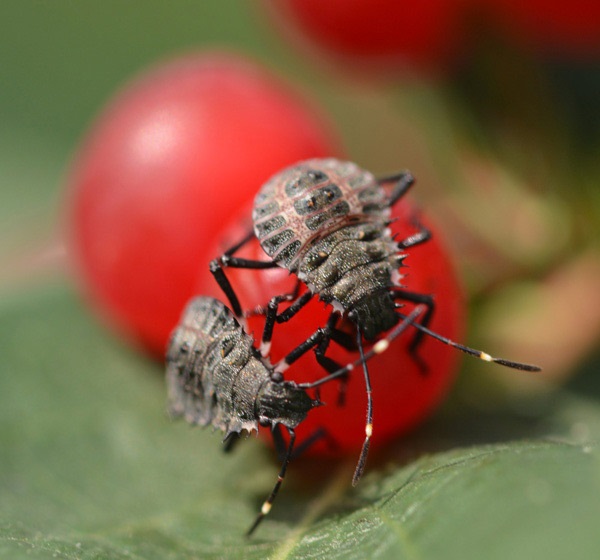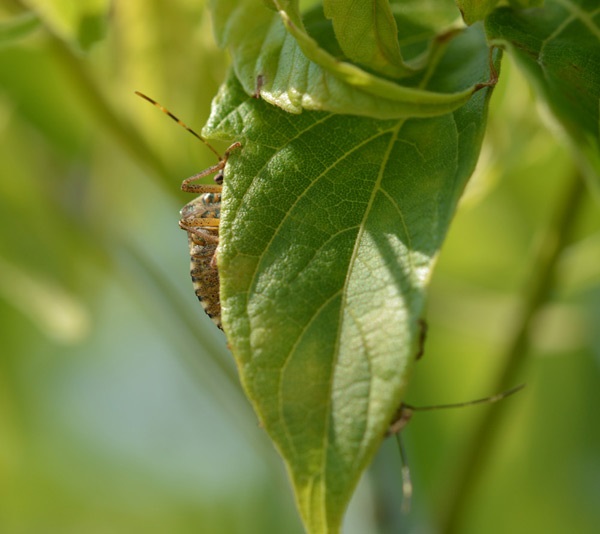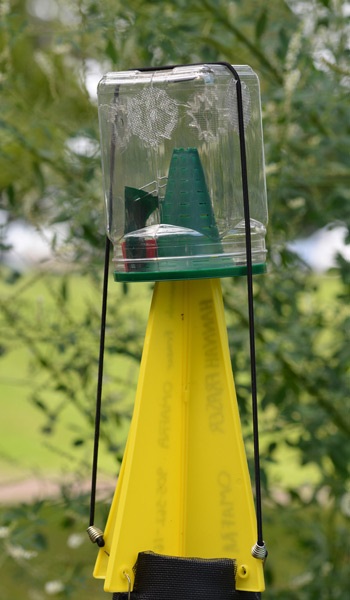Management strategies for Brown Marmorated Stink Bug
Information on management strategies for the control of brown marmorated stink bug.
The brown marmorated stink bug (BMSB) is a relatively new pest, and we are still learning about its biology and how to control it. Thresholds and management programs are being developed in the US, in areas where BMSB is abundant
Scouting for Brown Marmorated Stink Bug on Your Farm
BMSB adults and nymphs are quite mobile (not to mention great at hiding), and may be difficult to spot in the field, especially when numbers are low (Figure 2). Low numbers of BMSB observed when scouting may still equate to economic injury as populations increase, especially during very dry years. Make sure to look for signs of stink bug injury, especially along crop borders near woodlots, hedgerows, the Escarpment, etc. Early injury in tree fruit looks like water spots or small areas of bleeding, becoming depressed or sunken as fruit develops ('catfacing'). In apples, injury may take 2–3 weeks before it is obvious. Injury to tomatoes or peppers appears as discoloured spots ('halos'), with light-coloured spongy tissues under the skin. Because stink bugs are often present in numbers, and because they will make multiple punctures with their mouthparts, a single fruit or vegetable may have many points of injury. One BMSB can injury many fruits / vegetables over the course of its development. More descriptions and pictures are available on our webpages at Ontario.ca/stinkbug.
Pheromone traps are being recommended for use as early detection tools, to trigger intensive scouting in crops and to time insecticide applications. There are several models available, but almost all of them include some form of pyramid to direct the movement of the bugs and a collection container to trap and hold them. Traps are loaded with 1) a pheromone for BMSB, 2) a synergist ('MDT') to enhance performance through the season, and 3) an insecticide strip to kill bugs and help prevent them from escaping (Figure 3). There are various suppliers / types of pheromone lures; each has different performance characteristics and longevity. Traps should be placed in the field from May through harvest.
Finds of adults in traps are indicative that BMSB are established in the area but they do not always mean insecticide sprays are necessary. Adult BMSB are migratory, and so finding them in traps does not mean they are not simply on their way to some "better place". In contrast, the nymphs are resident pests and if present, they will continue feeding causing injury for a long time. Pest pressure is typically highest on the edges of fields. For this reason, traps are typically placed between crop borders and woody landscape hosts OR within the crop border. Since traps are not very efficient in capturing all BMSB they attract into the area, visual observation on the vegetation around the trap is also helpful in detection. If adults or nymphs are found in traps outside of the crop, intensive monitoring is needed. If nymphs are found in traps placed within a crop border, sprays are triggered. In tree fruit, the presence of adults or nymphs in the crop itself is enough to trigger an insecticide spray. For sweet corn, insecticide sprays should be initiated at tasseling if BMSB (adults or nymphs) are present and repeated as needed until harvest (see Stop BMSB). Detailed recommendations are not yet available for all horticultural crops.
Border sprays are sometimes sufficient for limiting damage, unless the pest has become established in the crop (keeping in mind BMSB may be difficult to spot - see above)
Keep in mind that sprays will only control those BMSB that are present at the time of application, or shortly thereafter, and nymphs are easier to kill than adults. Residual activity is typically limited. New waves of adults can migrate into crops from adjacent areas through the season. You will need to keep monitoring your crops. Managing BMSB requires your season-long attention.
Unfortunately, many of the products available for managing other crop pests are not effective against BMSB, requiring a shift in IPM programs.
Footnotes
- footnote[1] Back to paragraph Input provided by Dr. Greg and Krawczyk, Department of Entomology, Fruit Research and Extension Center, Pennsylvania State University, Peter J. Jentsch, Department of Entomology, Hudson Valley Laboratory, Cornell University, and Dr. Anne Nielsen, Rutgers University
- footnote[2] Back to paragraph Weekly border sprays applied to the perimeter of peach blocks (not the surrounding trees) plus the first full row have been used successfully in New Jersey, resulting in a significant decrease in the amount of insecticide used while keeping damage equal to full block sprays. Research to evaluate this tactic in apple is still underway (Anne Nielsen, Rutgers University)


